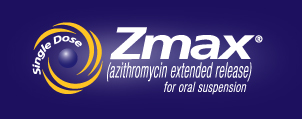

Macrolide
Staphylococcus aureus, Bacillus cereus, Bordetella pertussis, Chlamydia trachomatis, Corynebacterium diphtheriae, Gardnerella vaginalis, H. influenzae, Legionella pneumophila, Moraxella catarrhalis, Mycobacterium spp., Mycoplasma pneumoniae, Pasteurella multocida, S. pneumoniae, S. pyogenes.
Macrolides inhibit protein synthesis. They impair the elongation cycle of the peptidyl chain by specifically binding to the 50 S subunit of the ribosome.
Macrolides produce time-dependent killing
500mg dose: Cmax: 0.4mg/L; Half-life: 35-40 hours; Volume of distribution: 23-31 L/kg; Table 3
Gastrointestinal: abdominal cramps, nausea, diarrhea, anorexia, pancreatitis
Genitourinary: vulvovaginal candidiasis, renal failure
Cardiovascular System: prolongation of QT interval
Hepatic: hepatotoxicity, jaundice
Hematologic: eosinophilia, thrombocytosis, lymphopenia
Central Nervous System: headache, fatigue
Endocrine/Metabolic: hyperglycemia
Dermatologic: itching, nail discoloration
Oral: 250mg, 600mg tablet
1gram packet
100mg/5ml, 200mg/5ml powder for reconstitution to suspension
IV: 500mg vial
Acute bacterial exacerbations of COPD: 500mg PO q24h x 3 days, or 500mg on day 1, 250 mg q24h on days 2-5
Acute bacterial sinusitis 500mg PO q24h x 3 days
Cervicitis due to Chlamydia trachomatis: 1 gram PO x 1 dose
Cervicitis due to Neisseria gonorrhoeae: 2 gram PO x 1 dose
Chancroid (genital ulcer disease due to Haemophilus ducreyi): 1 gram PO x 1
Mycobacterium avium complex, prophylaxis: 1200mg PO q weekly
Mycobacterium avium complex, treatment: 500 mg PO q24h (in combination with ethambutol)
Pharyngitis/tonsillitis: 500mg PO day 1, then 250mg q24h on days 2-5
Community acquired pneumonia (mild severity): 500mg PO day 1, then 250mg q24h on days 2-5
Skin and skin structure infections (uncomplicated): 500mg PO day 1, 250mg q24h on days 2-5
Urethritis due to Chlamydia trachomatis: 1 gram PO x 1
Urethritis due to Neisseria gonorrhoeae: 2 gram PO x 1
Pelvic inflammatory disease: 500mg IV q24h for at least 2 days, then 250 mg PO q24h x 7 days total
Community acquired pneumonia: 500mg IV q24h x at least 2 days, followed by 500mg PO q24h x 7-10 days total.
Acute bacterial sinusitis (> 6 months): 10 mg/kg PO q24h x 3 days
Mycobacterium avium complex disease, primary prevention: 20 mg/kg PO q weekly (maximum per dose 1200 mg)
Mycobacterium avium complex disease, secondary prevention: 5 mg/kg q24h (maximum dose 250mg) PO combined with ethambutol
Mycobacterium avium complex disease, treatment: 5 mg/kg up to 20 mg/kg PO x 1 month or longer
Otitis media, acute (> 6 months): 30mg/kg PO x 1, or 10mg/kg PO q24h x 3 days, or 10 mg/kg PO on day 1 followed by 5 mg/kg PO q24h on days 2-5
Pharyngitis, tonsillitis (>2 years old): 12 mg/kg PO q24h x 5 days
Pharyngitis/tonsillitis (second-line therapy): (>16 years) 500 mg PO day 1, then 250 mg q24h on days 2-5
Pneumonia, community-acquired (>6 months): 10 mg/kg PO day 1, then 5 mg/kg q24h on days 2-5
Pneumonia, community-acquired (mild severity): (>16 years) 500mg PO day 1, then 250 mg q24h on days 2-5
Skin and skin structure infections (uncomplicated): (>16 years) 500mg PO on day 1, then 250mg q24h on days 2-5
Hepatic failures: No adjustment necessary
Renal failures: No adjustment necessary, however should be used with caution in patients with CrCl < 10ml/min. No supplemental doses needed after dialysis.
Contraindicated: Coadministration with astemizole, cisapride, ergotamine, terfenadine
Precautions: May prolong the QTc interval
Due to its hepatic metabolism, caution should be exercised when administering this agent with other drugs metabolized in the liver. The following drug interactions are clinically relevant but do not represent the comprehensive list of documented or potential drug-drug interactions.
Amiodarone: Incereased risk of cardiotoxicity (QTc prolongation)
Cyclosporine: Concomitant administration may increase cyclosporine levels. Close monitoring of cyclosporine levels is recommended
Nelfinavir: Coadministration may lead to increased azithromycin levels
Phenytoin: Concomitant administration may increase phenytoin levels. Close monitoring of phenytoin levels is recommended
Category B: No evidence of risk in humans but studies inadequate.
Therapeutic: Periodic WBC, chest X-ray if pneumonia, cultures, temperature
ZITHROMAX (Pfizer – MALAYSIA, THAILAND, SINGAPORE, FINLAND, NEW ZEALAND, ISRAEL, GREECE, CHILE, UNITED KINGDOM, USA, FRANCE, NETHERLANDS, AUSTRIA, AUSTRALIA, GERMANY, SWITZERLAND, SOUTH AFRICA, IRELAND, CANADA, PORTUGAL, HONG KONG)
For a complete manufacturer's list, please click